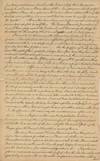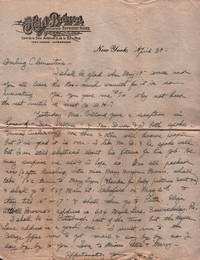7.5 x 12 inches, six pages, one leaf torn at fold, else about fine
1781 · Uwchlan, Pennsylvania
by [Quakers – Women – Colonial America] Lightfoot, Susanna
Uwchlan, Pennsylvania, 1781. 7.5 x 12 inches, six pages, one leaf torn at fold, else about fine. Overall very good. Susanna Lightfoot (1720–1781) was born Susanna Hudson in Grange, County Antrim, Ireland, to English Quaker parents. From the start, Quakerism had allowed women to speak at meetings—to minister—and Lightfoot began to do so at 17, while she was employed as a servant for wealthy fellow Quaker Ruth Courtney. Lightfoot became known for her ministry, and traveled around Colonial America and the United Kingdom and between the continents, ministering at various meetings. She lived most of her life in poverty, supported by the charity of Friends,
(truncated) before her death in 1781 following a lengthy illness. Offered here is a short biography of Susanna Lightfoot that was presented at the Uwchlan Monthly Meeting following her death.
The biography describes a young Lightfoot as traveling “many Miles on foot to” meetings around Ireland, as “such was her love to the truth, and Zeal”. At these meetings:
“She has frequently been heard to speak of with tenderness of Spirit, for the encouragement of Servants and others in low Circumstances; and that the Rich and full, who have horses to ride on, and blest both with the necessaries and conveniences of life, might prize their time and priviledges; and bring forth fruits adaquate to the favours confered on them in this once highly favoured Country.”
In 1737 she came to America with Ruth Courtney to minister, with Uwchlan as one of their stops: the biography notes that “some of us hav[e] cause to Remember her and the sweetness of her spirit at that time.” After a little over a year, the pair traveled back over the Atlantic, and Lightfoot ministered around England, Wales, and Scotland. Lightfoot married Joseph Hatton in 1742, and the two attempted to open a store in Lisburn, but could not keep up with the store and raise their children. They moved to Lurgan, living on a Friend’s lease and taking charity from the local Quaker community. They were then invited to live in Waterford, where their financial situation improved somewhat, until Hatton’s death in 1759.[1] Following his death, Lightfoot received the approval of the London elders to return to America:
“And in the Year 1760 in the Constraining love of Truth, she entered on a Second visit to America [...] which concern she not only laid before her friends at home [...] but in a Sollid affecting manner moved the same in the Yearly Meeting of Ministers and Elders in London and had their Sympathy and unity expressed by Certificate.”
On this trip she would meet Thomas Lightfoot, and the two would marry back in Ireland. Also on this trip, she is credited with attending the Treaty of Easton—an agreement during the French and Indian War between the British and Native Americans—and with ministering to a group of Native Americans led by the chief Papunahung.[2] In 1764, the Lightfoots settled for good in Pennsylvania, joining the Uwchlan Monthly Meeting. Her ministry began to take a darker tone as the 1770s progressed:
“Cloathed of the Lord with dignity and Zeal, she at divers meetings previous to the breaking forth of the present calimity, had in an Aweful manner to proclaim the Approaching of a stormy day, which would shake the sandy foundations of men, and many of the formal professors in our Society, should be blown away as by the breath of his holy Nostrils, which has since been lamentably fulfill’d on some.”
The ‘present calamity’, of course, refers to the ongoing Revolutionary War. Much of the remainder of the biography reproduces ministry that Lightfoot had given at meetings closer to her death, from how she was “grieved to see the haughtiness of the Young men and the folly of the Young women” to her warning that “Well would it have been for the old world had they taken warning at the sound of the hammer in building the Ark”. Her biographers write,
“Much more might be Truly said concerning this our endeared missing friend, and of our great loss of her, but we trust it is more the desire of a remnant amongst us, both Young and Old, to endeavour in our measures to follow her as she followed Christ; and that we and all who have been partaken of her Pious labours nay be animated to talk that we may have grounds to hope our latter end may be like unto hers”.
Of interest to scholars of Quaker history and particularly of women’s roles in the history of religion.
[1] Mary Leadbeater, Biographical notices of members of the Society of Friends, who were resident in Ireland (London: Harvey and Darton, 1823), 278-9.
[2] Ormerod Greenwood, “John Woolman and Susanna Lightfoot,” The Journal of the Friends' Historical Society 48, no. 4 (Autumn 1957).
(Inventory #: List2744)









![Exodus Is An Illumination Theatre of Madness An Laughter Poetry and Thieves to Steal Your Soul [Flyer for a Berkeley Performance by the San Francisco Mime Troupe and Others]](https://d3525k1ryd2155.cloudfront.net/h/479/906/1692906479.0.m.jpg)